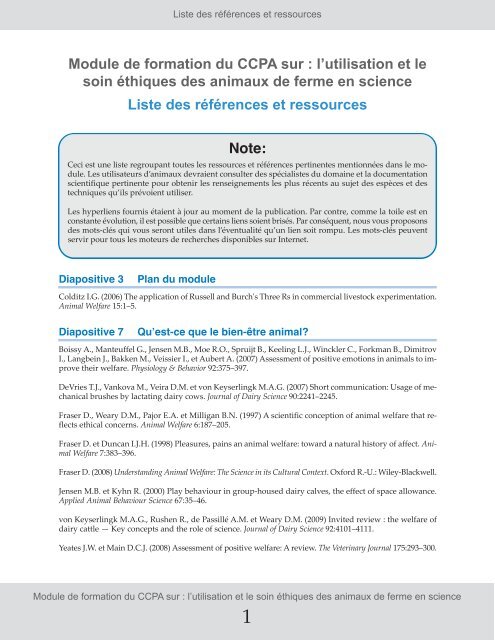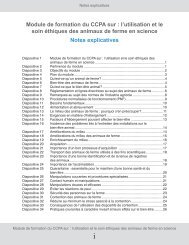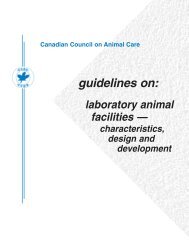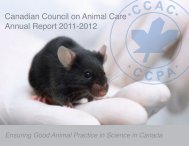Module de formation du CCPA sur : l'utilisation et le soin éthiques ...
Module de formation du CCPA sur : l'utilisation et le soin éthiques ...
Module de formation du CCPA sur : l'utilisation et le soin éthiques ...
Create successful ePaper yourself
Turn your PDF publications into a flip-book with our unique Google optimized e-Paper software.
Diapositive 3 Plan <strong>du</strong> mo<strong>du</strong><strong>le</strong><br />
Liste <strong>de</strong>s références <strong>et</strong> ressources<br />
<strong>Mo<strong>du</strong><strong>le</strong></strong> <strong>de</strong> <strong>formation</strong> <strong>du</strong> <strong>CCPA</strong> <strong>sur</strong> : l’utilisation <strong>et</strong> <strong>le</strong><br />
<strong>soin</strong> <strong>éthiques</strong> <strong>de</strong>s animaux <strong>de</strong> ferme en science<br />
Liste <strong>de</strong>s références <strong>et</strong> ressources<br />
Note:<br />
Ceci est une liste regroupant toutes <strong>le</strong>s ressources <strong>et</strong> références pertinentes mentionnées dans <strong>le</strong> mo<strong>du</strong><strong>le</strong>.<br />
Les utilisateurs d’animaux <strong>de</strong>vraient consulter <strong>de</strong>s spécialistes <strong>du</strong> domaine <strong>et</strong> la documentation<br />
scientifique pertinente pour obtenir <strong>le</strong>s renseignements <strong>le</strong>s plus récents au suj<strong>et</strong> <strong>de</strong>s espèces <strong>et</strong> <strong>de</strong>s<br />
techniques qu’ils prévoient utiliser.<br />
Les hyperliens fournis étaient à jour au moment <strong>de</strong> la publication. Par contre, comme la toi<strong>le</strong> est en<br />
constante évolution, il est possib<strong>le</strong> que certains liens soient brisés. Par conséquent, nous vous proposons<br />
<strong>de</strong>s mots-clés qui vous seront uti<strong>le</strong>s dans l’éventualité qu’un lien soit rompu. Les mots-clés peuvent<br />
servir pour tous <strong>le</strong>s moteurs <strong>de</strong> recherches disponib<strong>le</strong>s <strong>sur</strong> Intern<strong>et</strong>.<br />
Colditz I.G. (2006) The application of Russell and Burch's Three Rs in commercial livestock experimentation.<br />
Animal Welfare 15:1–5.<br />
Diapositive 7 Qu’est-ce que <strong>le</strong> bien-être animal?<br />
Boissy A., Manteuffel G., Jensen M.B., Moe R.O., Spruijt B., Keeling L.J., Winck<strong>le</strong>r C., Forkman B., Dimitrov<br />
I., Langbein J., Bakken M., Veissier I., <strong>et</strong> Aubert A. (2007) Assessment of positive emotions in animals to improve<br />
their welfare. Physiology & Behavior 92:375–397.<br />
DeVries T.J., Vankova M., Veira D.M. <strong>et</strong> von Keyserlingk M.A.G. (2007) Short communication: Usage of mechanical<br />
brushes by lactating dairy cows. Journal of Dairy Science 90:2241–2245.<br />
Fraser D., Weary D.M., Pajor E.A. <strong>et</strong> Milligan B.N. (1997) A scientific conception of animal welfare that ref<strong>le</strong>cts<br />
<strong>et</strong>hical concerns. Animal Welfare 6:187–205.<br />
Fraser D. <strong>et</strong> Duncan I.J.H. (1998) P<strong>le</strong>a<strong>sur</strong>es, pains an animal welfare: toward a natural history of affect. Animal<br />
Welfare 7:383–396.<br />
Fraser D. (2008) Un<strong>de</strong>rstanding Animal Welfare: The Science in its Cultural Context. Oxford R.-U.: Wi<strong>le</strong>y-Blackwell.<br />
Jensen M.B. <strong>et</strong> Kyhn R. (2000) Play behaviour in group-housed dairy calves, the effect of space allowance.<br />
Applied Animal Behaviour Science 67:35–46.<br />
von Keyserlingk M.A.G., Rushen R., <strong>de</strong> Passillé A.M. <strong>et</strong> Weary D.M. (2009) Invited review : the welfare of<br />
dairy catt<strong>le</strong> — Key concepts and the ro<strong>le</strong> of science. Journal of Dairy Science 92:4101–4111.<br />
Yeates J.W. <strong>et</strong> Main D.C.J. (2008) Assessment of positive welfare: A review. The V<strong>et</strong>erinary Journal 175:293–300.<br />
<strong>Mo<strong>du</strong><strong>le</strong></strong> <strong>de</strong> <strong>formation</strong> <strong>du</strong> <strong>CCPA</strong> <strong>sur</strong> : l’utilisation <strong>et</strong> <strong>le</strong> <strong>soin</strong> <strong>éthiques</strong> <strong>de</strong>s animaux <strong>de</strong> ferme en science<br />
1
Liste <strong>de</strong>s références <strong>et</strong> ressources<br />
Diapositive 8 Rég<strong>le</strong>mentation <strong>et</strong> lignes directrices au suj<strong>et</strong> <strong>de</strong>s animaux<br />
<strong>de</strong> ferme<br />
Échelon national – Transport : Règ<strong>le</strong>ment <strong>sur</strong> la santé <strong>de</strong>s animaux (partie XII)<br />
• Les propositions découlant <strong>de</strong> ce règ<strong>le</strong>ment présentent <strong>le</strong>s conditions requises pour as<strong>sur</strong>er un transport<br />
sans cruauté <strong>de</strong> tout animal. Le règ<strong>le</strong>ment interdit toute souffrance causée par <strong>le</strong> transport d’animaux<br />
b<strong>le</strong>ssés ou mala<strong>de</strong>s ainsi que <strong>le</strong> transport <strong>de</strong>s animaux inaptes à voyager. En plus <strong>de</strong> déterminer <strong>le</strong>s critères<br />
<strong>de</strong> conception <strong>de</strong>s types <strong>de</strong> véhicu<strong>le</strong>s <strong>et</strong> <strong>le</strong>s exigences en matière <strong>de</strong> litière, <strong>le</strong> règ<strong>le</strong>ment interdit<br />
éga<strong>le</strong>ment <strong>le</strong> transport d’animaux incompatib<strong>le</strong>s <strong>et</strong> l’entassement <strong>de</strong>s animaux au point où ceux-ci pourraient<br />
se b<strong>le</strong>sser ou souffrir <strong>de</strong> c<strong>et</strong>te situation. La <strong>du</strong>rée maximum <strong>du</strong> voyage <strong>et</strong> <strong>de</strong> l’absence d’eau <strong>et</strong> <strong>de</strong><br />
nourriture y est indiquée selon l’espèce.<br />
• Il faut préciser que <strong>le</strong> Règ<strong>le</strong>ment <strong>sur</strong> la santé <strong>de</strong>s animaux (partie XII) ne traite que <strong>de</strong>s be<strong>soin</strong>s <strong>de</strong>s animaux<br />
<strong>du</strong>rant <strong>le</strong> transport <strong>et</strong> qu’il ne s’applique pas au <strong>soin</strong> ni à la manipulation dans d’autres situations.<br />
• Ce règ<strong>le</strong>ment est mis en application par l’ACIA.<br />
• http://laws.justice.gc.ca/fra/C.R.C.-ch.296/page-8.html<br />
Échelon national – Manipulation <strong>et</strong> abattage sans cruauté : Loi <strong>sur</strong> l'inspection<br />
<strong>de</strong>s vian<strong>de</strong>s (artic<strong>le</strong>s 61 à 80)<br />
• C<strong>et</strong>te loi établit <strong>le</strong>s normes pour la manipulation <strong>et</strong> l'abattage sans cruauté <strong>de</strong>s animaux <strong>de</strong>stinés à la<br />
consommation dans <strong>le</strong>s abattoirs agréés par <strong>le</strong> fédéral. El<strong>le</strong> interdit toute manipulation causant <strong>de</strong> la détresse<br />
ou <strong>de</strong> la dou<strong>le</strong>ur pouvant être évitée, y compris l’utilisation d’aiguillons, qu’ils soient é<strong>le</strong>ctriques<br />
ou non, <strong>sur</strong> <strong>le</strong>s régions sensib<strong>le</strong>s (la tête, l’anus ou <strong>le</strong>s parties génita<strong>le</strong>s) <strong>de</strong> l’animal. De plus, c<strong>et</strong>te loi interdit<br />
d’héberger <strong>de</strong>s espèces différentes dans un même lieu <strong>et</strong> précise <strong>le</strong>s be<strong>soin</strong>s d’abreuvement <strong>et</strong> d’alimentation<br />
qui doivent être as<strong>sur</strong>és avant l’abattage.<br />
• C<strong>et</strong>te loi est mise en application par l’ACIA.<br />
• http://laws.justice.gc.ca/fra/DORS-90-288/page-4.html<br />
Échelon national – Souffrance : Co<strong>de</strong> criminel <strong>du</strong> Canada (artic<strong>le</strong>s 444 à 446)<br />
• Ce co<strong>de</strong> juridique fédéral interdit à toute personne <strong>de</strong> faire volontairement souffrir un animal que ce soit<br />
par la négligence ou bien en infligeant <strong>de</strong> la dou<strong>le</strong>ur ou <strong>de</strong>s b<strong>le</strong>s<strong>sur</strong>es. L’artic<strong>le</strong> 444 vise particulièrement<br />
<strong>le</strong>s bovins alors que <strong>le</strong>s artic<strong>le</strong>s 445 <strong>et</strong> 446 portent <strong>sur</strong> tous <strong>le</strong>s autres animaux, y compris <strong>le</strong>s oiseaux.<br />
• Mise en application par <strong>le</strong>s forces policières, par la Société pour la prévention envers la cruauté envers<br />
<strong>le</strong>s animaux (SPCA) ou par <strong>de</strong>s agents d’autres sociétés pour la protection <strong>de</strong>s animaux.<br />
• http://laws.justice.gc.ca/fra/AvisMiseJour<br />
(Remarque : si l’un ou l’autre <strong>de</strong>s liens ci-<strong>de</strong>ssus est rompu, cherchez : ministère <strong>de</strong> la Justice Canada <strong>et</strong> utilisez<br />
<strong>le</strong>s ongl<strong>et</strong>s « Lois par titre » <strong>et</strong> « Règ<strong>le</strong>ments par titre » pour trouver <strong>le</strong> document désiré).<br />
Échelon national – Étu<strong>de</strong>s <strong>sur</strong> <strong>le</strong>s médicaments <strong>et</strong> <strong>le</strong>s vaccins<br />
• Les étu<strong>de</strong>s qui <strong>de</strong>man<strong>de</strong>nt <strong>de</strong> tester <strong>de</strong> nouveaux médicaments <strong>et</strong> <strong>de</strong>s vaccins <strong>sur</strong> <strong>de</strong>s animaux <strong>de</strong>stinés<br />
à la consommation peuvent <strong>de</strong>voir être soumises à l’approbation <strong>de</strong> l’ACIA ou <strong>de</strong> Santé Canada.<br />
• Pour <strong>le</strong>s nouveaux vaccins, consultez la Section <strong>de</strong>s pro<strong>du</strong>its biologiques vétérinaires <strong>de</strong> l’ACIA au :<br />
http://www.inspection.gc.ca/francais/anima/v<strong>et</strong>bio/vbpbvf.shtml (Remarque : Si <strong>le</strong> lien est rompu, cherchez<br />
: Pro<strong>du</strong>its biologiques vétérinaires ACIA)<br />
<strong>Mo<strong>du</strong><strong>le</strong></strong> <strong>de</strong> <strong>formation</strong> <strong>du</strong> <strong>CCPA</strong> <strong>sur</strong> : l’utilisation <strong>et</strong> <strong>le</strong> <strong>soin</strong> <strong>éthiques</strong> <strong>de</strong>s animaux <strong>de</strong> ferme en science<br />
2
Liste <strong>de</strong>s références <strong>et</strong> ressources<br />
• Pour <strong>le</strong>s nouveaux médicaments, consultez la Direction <strong>de</strong>s médicaments vétérinaires (DMV), Santé<br />
Canada :<br />
• Distribution <strong>de</strong> médicaments d’urgence : http://www.hc-sc.gc.ca/dhp-mps/v<strong>et</strong>/edr-dmu/in<strong>de</strong>x-fra.<br />
php (Remarque : Si <strong>le</strong> lien est rompu, cherchez : Distribution <strong>de</strong> médicaments d’urgence Santé Canada)<br />
• Certificat d'étu<strong>de</strong>s expérimenta<strong>le</strong>s : http://www.hc-sc.gc.ca/dhp-mps/v<strong>et</strong>/applic-<strong>de</strong>man<strong>de</strong>/form/<br />
esc-cee_08-2002-fra.php (Remarque : Si <strong>le</strong> lien est rompu, cherchez : Certificat d'étu<strong>de</strong>s expérimenta<strong>le</strong>s<br />
pour <strong>le</strong>s médicaments vétérinaires Santé Canada)<br />
Organisations provincia<strong>le</strong>s <strong>et</strong> non gouvernementa<strong>le</strong>s<br />
• Toutes <strong>le</strong>s provinces <strong>et</strong> <strong>le</strong>s territoires ont une législation régissant <strong>le</strong> <strong>soin</strong> <strong>de</strong>s animaux. Nombre d’organisations<br />
non gouvernementa<strong>le</strong>s rédigent <strong>de</strong>s recommandations portant <strong>sur</strong> <strong>le</strong> <strong>soin</strong> <strong>et</strong> l’utilisation <strong>de</strong>s<br />
animaux. Un résumé <strong>de</strong>s règ<strong>le</strong>ments <strong>et</strong> <strong>de</strong>s lignes directrices disponib<strong>le</strong>s, y compris <strong>le</strong> détail <strong>de</strong>s lignes<br />
directrices pro<strong>du</strong>ites par <strong>de</strong>s organisations non gouvernementa<strong>le</strong>s, peut être consulté au http://www.inspection.gc.ca/francais/anima/trans/infraf.shtml<br />
(Remarque : Si <strong>le</strong> lien est rompu, cherchez : Bien-être <strong>de</strong>s<br />
animaux au Canada selon l’ACIA)<br />
• Le Conseil national pour <strong>le</strong> <strong>soin</strong> <strong>de</strong>s animaux d’é<strong>le</strong>vage (CNSAE) propose <strong>de</strong>s Co<strong>de</strong>s <strong>de</strong> pratiques recommandées<br />
pour <strong>le</strong> <strong>soin</strong> <strong>et</strong> la manipulation <strong>de</strong>s animaux <strong>de</strong> ferme. Tous <strong>le</strong>s co<strong>de</strong>s <strong>de</strong> pratiques disponib<strong>le</strong>s<br />
peuvent être consultés <strong>sur</strong> <strong>le</strong> site <strong>du</strong> CNSAE : http://www.nfacc.ca/Francais/co<strong>de</strong>.aspx (Remarque :<br />
Si <strong>le</strong> lien est rompu, cherchez : Co<strong>de</strong>s CNSAE)<br />
Lorsque <strong>de</strong>s proj<strong>et</strong>s <strong>de</strong> recherche doit être directement pertinent à l’in<strong>du</strong>strie agrico<strong>le</strong>, ces co<strong>de</strong>s <strong>de</strong> pratique<br />
<strong>de</strong>vraient servir <strong>de</strong> normes minima<strong>le</strong>s, mais el<strong>le</strong>s doivent être approuvées par un comité <strong>de</strong> protection<br />
<strong>de</strong>s animaux (CPA).<br />
Diapositive 9 Remarques au suj<strong>et</strong> <strong>de</strong>s normes <strong>de</strong> l’in<strong>du</strong>strie agrico<strong>le</strong><br />
Lignes directrices <strong>du</strong> <strong>CCPA</strong> <strong>sur</strong> : <strong>le</strong> <strong>soin</strong> <strong>et</strong> <strong>l'utilisation</strong> <strong>de</strong>s animaux <strong>de</strong> ferme en recherche, en enseignement <strong>et</strong> dans<br />
<strong>le</strong>s tests (2009) : Visitez <strong>le</strong> site Web <strong>du</strong> <strong>CCPA</strong> au www.ccac.ca pour consulter ces lignes directrices.<br />
Diapositive 10 Procé<strong>du</strong>res normalisées <strong>de</strong> fonctionnement (PNF)<br />
Normes <strong>de</strong> l'ACMAL <strong>sur</strong> <strong>le</strong>s <strong>soin</strong>s vétérinaires (2007) http://calam-acmal.org/pdfs/DeclarationACMAL.pdf)<br />
(Remarque : Si <strong>le</strong> lien est rompu, cherchez : ACMAL normes <strong>de</strong> <strong>soin</strong>s vétérinaires)<br />
Food Animal Resi<strong>du</strong>e Avoidance Databank, FARAD, http://www.farad.org/) (Remarque : Si <strong>le</strong> lien est<br />
rompu, cherchez Food Animal Resi<strong>du</strong>e Avoidance Databank)<br />
Diapositive 12 Alimentation <strong>et</strong> abreuvement<br />
La qualité <strong>de</strong> l'eau d'abreuvement <strong>du</strong> bétail. Gui<strong>de</strong> <strong>de</strong> terrain relatif aux bovins, aux chevaux, à la volail<strong>le</strong> <strong>et</strong> aux porcs<br />
d’Agriculture <strong>et</strong> Agroalimentaire Canada. http://www4.agr.gc.ca/AAFC-AAC/display-afficher.do?id=<br />
1259101276424&lang=fra (Remarque : Si <strong>le</strong> lien est rompu, cherchez : Agriculture Canada Gui<strong>de</strong> <strong>de</strong> terrain<br />
relatif aux bovins, aux chevaux, à la volail<strong>le</strong> <strong>et</strong> aux porcs)<br />
Recommandations canadiennes pour la qualité <strong>de</strong>s eaux : protection <strong>de</strong>s utilisations <strong>de</strong> l’eau à <strong>de</strong>s fins agrico<strong>le</strong>s <strong>du</strong><br />
Conseil canadien <strong>de</strong>s ministres <strong>de</strong> l'environnement : http://ceqg-rcqe.ccme.ca/ (Remarque : Si <strong>le</strong> lien est<br />
rompu, cherchez : RCQE Recommandations protection <strong>de</strong>s utilisations <strong>de</strong> l’eau à <strong>de</strong>s fins agrico<strong>le</strong>s)<br />
<strong>Mo<strong>du</strong><strong>le</strong></strong> <strong>de</strong> <strong>formation</strong> <strong>du</strong> <strong>CCPA</strong> <strong>sur</strong> : l’utilisation <strong>et</strong> <strong>le</strong> <strong>soin</strong> <strong>éthiques</strong> <strong>de</strong>s animaux <strong>de</strong> ferme en science<br />
3
Liste <strong>de</strong>s références <strong>et</strong> ressources<br />
DeVries T.J., von Keyserlingk M.A.G. <strong>et</strong> Beauchemin K.A. (2005) Frequency of Feed Delivery Affects the Behavior<br />
of Lactating Dairy Cows. Journal of Dairy Science 88:3553–3562.<br />
National Research Council (NRC) (1985) Nutrient Requirements of Sheep, 6 e éd. Washington DC: National<br />
Aca<strong>de</strong>my Press.<br />
National Research Council (NRC) (1994) Nutrient Requirements of Poultry, 9 e éd. Washington DC: National<br />
Aca<strong>de</strong>my Press.<br />
National Research Council (NRC) (1998) Nutrient Requirements of Swine, 10 e éd. Washington DC: National<br />
Aca<strong>de</strong>my Press.<br />
National Research Council (NRC) (2000) Nutrient Requirements of Beef Catt<strong>le</strong>, 7 e éd. Washington DC: National<br />
Aca<strong>de</strong>my Press.<br />
National Research Council (NRC) (2001) Nutrient Requirements of Dairy Catt<strong>le</strong>, 7 e éd. Washington DC: National<br />
Aca<strong>de</strong>my Press.<br />
Diapositive 14 Exigences en matière d’hébergement<br />
<strong>Mo<strong>du</strong><strong>le</strong></strong> <strong>de</strong> <strong>formation</strong> <strong>du</strong> <strong>CCPA</strong> <strong>sur</strong> : l’enrichissement <strong>du</strong> milieu (2003). Visitez <strong>le</strong> site Web <strong>du</strong> <strong>CCPA</strong> au<br />
www.ccac.ca pour consulter ce mo<strong>du</strong><strong>le</strong> <strong>de</strong> <strong>formation</strong>.<br />
Diapositive 16 Inci<strong>de</strong>nce <strong>de</strong>s problèmes liés à l'entr<strong>et</strong>ien <strong>de</strong>s installations<br />
<strong>sur</strong> <strong>le</strong> bien-être animal<br />
Gui<strong>de</strong> for the Care and Use of Agricultural Animals in Agricultural Research and Teaching, Third Edition (FASS,<br />
2010) : http://www.fass.org/page.asp?pageID=216 (Remarque : Si <strong>le</strong> lien est rompu, cherchez : FASS pdf<br />
gui<strong>de</strong> for the care and use of agricultural animals in research and teaching)<br />
Diapositive 17 Améliorations <strong>du</strong> milieu<br />
Damm B.I., Pe<strong>de</strong>rsen L.J., Heiskanen T. <strong>et</strong> Nielsen N.P. (2005) Long-stemmed straw as an additional nesting<br />
material in modified Schmid pens in a commercial breeding unit: effects on sow behaviour, and on pigl<strong>et</strong><br />
mortality and growth. Applied Animal Behaviour Science 92:45–60.<br />
Hughes B.O. <strong>et</strong> Duncan I.J.H. (1988) The notion of <strong>et</strong>hological 'need', mo<strong>de</strong>ls of motivation and animal welfare.<br />
Animal Behaviour 36:1696–1707.<br />
Rushen J. <strong>et</strong> <strong>de</strong> Passillé A.M. (1995) The motivation of non-nutritive sucking calve Bos Taurus. Animal Behaviour<br />
49:1503–1510.<br />
Diapositive 18 Améliorations <strong>du</strong> milieu <strong>de</strong>s animaux <strong>de</strong> ferme<br />
Arey D.S., P<strong>et</strong>chey A.M. <strong>et</strong> Fow<strong>le</strong>r V.R. (1991) The preparturient behaviour of sows in enriched pens and<br />
the effect of pre-formed nests. Applied Animal Behaviour Science 31:61–68.<br />
Bilcik B. <strong>et</strong> Keeling L.J. (1999) Changes in feather condition in relation to feather pecking and aggressive behaviour<br />
in laying hens. British Poultry Science 40:444–51.<br />
<strong>Mo<strong>du</strong><strong>le</strong></strong> <strong>de</strong> <strong>formation</strong> <strong>du</strong> <strong>CCPA</strong> <strong>sur</strong> : l’utilisation <strong>et</strong> <strong>le</strong> <strong>soin</strong> <strong>éthiques</strong> <strong>de</strong>s animaux <strong>de</strong> ferme en science<br />
4
Liste <strong>de</strong>s références <strong>et</strong> ressources<br />
Panivivat R., Keg<strong>le</strong>y E.B., Pennington J.A., Kellogg D.W. <strong>et</strong> Krumpelman S.L. (2004) Growth performance<br />
and health of dairy calves bed<strong>de</strong>d with different types of materials. Journal of Dairy Science 87:3736–3745.<br />
Diapositive 19 Enrichissement <strong>du</strong> milieu<br />
<strong>Mo<strong>du</strong><strong>le</strong></strong> <strong>de</strong> <strong>formation</strong> <strong>du</strong> <strong>CCPA</strong> <strong>sur</strong> : l’enrichissement <strong>du</strong> milieu (2003). Visitez <strong>le</strong> site Web <strong>du</strong> <strong>CCPA</strong> au<br />
www.ccac.ca pour consulter ce mo<strong>du</strong><strong>le</strong> <strong>de</strong> <strong>formation</strong>.<br />
Wilson S.C., Mitlöhnera F.M., Morrow-Tesch J., Dai<strong>le</strong>y J.W. <strong>et</strong> McGlone J.J. (2002) An assessment of several<br />
potential enrichment <strong>de</strong>vices for feedlot catt<strong>le</strong>. Applied Animal Behaviour Science 76:259–265.<br />
Young R.W. (éd.) (2003) Environmental Enrichment for Captive Animals. Oxford R.-U.: Wi<strong>le</strong>y-Blackwell.<br />
Diapositive 21 Importance d’un bon processus d’acquisition<br />
Scientific Committee on Animal Health and Animal Welfare. (2000). The Welfare of Chickens Kept for Meat<br />
Pro<strong>du</strong>ction (Broi<strong>le</strong>rs). European Commission, Health & Consumer Protection Directorate-General :<br />
http://ec.europa.eu/food/fs/sc/scah/out39_en.pdf (Remarque : Si <strong>le</strong> lien est rompu, cherchez : Europe welfare<br />
of chickens kept for meat)<br />
Diapositive 22 Transport <strong>de</strong>s animaux <strong>de</strong> ferme utilisés à <strong>de</strong>s<br />
fins scientifiques<br />
Règ<strong>le</strong>ment <strong>sur</strong> la santé <strong>de</strong>s animaux (partie XII) : http://laws.justice.gc.ca/fra/C.R.C.-ch.296/page-8.html (Remarque<br />
: Si <strong>le</strong> lien est rompu, cherchez : ministère <strong>de</strong> la Justice Canada <strong>et</strong> sous l’ongl<strong>et</strong> « Règ<strong>le</strong>ments par<br />
titre » pour trouver <strong>le</strong> Règ<strong>le</strong>ment <strong>sur</strong> la santé <strong>de</strong>s animaux.)<br />
Co<strong>de</strong> <strong>de</strong> pratiques recommandées pour <strong>le</strong> <strong>soin</strong> <strong>et</strong> la manipulation <strong>de</strong>s animaux <strong>de</strong> ferme –Transport, 2001 :<br />
http://www.nfacc.ca/Francais/pdf/french/Transport.pdf (Remarque : Si <strong>le</strong> lien est rompu, cherchez : CNSAE<br />
co<strong>de</strong>s <strong>et</strong> choisissez « Transport (2001) »)<br />
Diapositive 23 Importance d’une bonne i<strong>de</strong>ntification <strong>et</strong> <strong>de</strong> la tenue <strong>de</strong><br />
registres <strong>de</strong>s animaux<br />
Renseignements <strong>sur</strong> la traçabilité <strong>du</strong> bétail par l’ACIA : http://www.inspection.gc.ca/francais/anima/trac/<br />
tracf.shtml (Remarque : Si <strong>le</strong> lien est rompu, cherchez : ACIA bétail)<br />
Renseignements <strong>sur</strong> l’i<strong>de</strong>ntification <strong>de</strong>s bovins par l’ACIB : http://www.canadaid.com/fr/in<strong>de</strong>x.html/<br />
(Remarque : Si <strong>le</strong> lien est rompu, cherchez : ACIB bovins)<br />
Diapositive 25 Quarantaine : essentiel<strong>le</strong> pour <strong>le</strong> maintien d’une bonne<br />
santé <strong>et</strong> <strong>du</strong> bien-être<br />
<strong>Mo<strong>du</strong><strong>le</strong></strong> <strong>de</strong> <strong>formation</strong> <strong>du</strong> <strong>CCPA</strong> <strong>sur</strong> : la santé <strong>et</strong> la sécurité au travail (2003). Visitez <strong>le</strong> site Web <strong>du</strong> <strong>CCPA</strong> au<br />
www.ccac.ca pour consulter ce mo<strong>du</strong><strong>le</strong> <strong>de</strong> <strong>formation</strong>.<br />
Diapositive 29 Éviter <strong>le</strong>s réactions <strong>de</strong> peur<br />
Hemsworth P.H. <strong>et</strong> Barn<strong>et</strong>t J.L. (1991) The effects of aversively handling pigs either indivi<strong>du</strong>ally or in groups<br />
on their behaviour, growth and corticosteroids. Applied Animal Behaviour Science 30:61–72.<br />
<strong>Mo<strong>du</strong><strong>le</strong></strong> <strong>de</strong> <strong>formation</strong> <strong>du</strong> <strong>CCPA</strong> <strong>sur</strong> : l’utilisation <strong>et</strong> <strong>le</strong> <strong>soin</strong> <strong>éthiques</strong> <strong>de</strong>s animaux <strong>de</strong> ferme en science<br />
5
Liste <strong>de</strong>s références <strong>et</strong> ressources<br />
Rushen J., <strong>de</strong>Passillé A.M. <strong>et</strong> Munksgaard L. (1999) Fear of peop<strong>le</strong> by cows and effects on milk yield, behavior,<br />
and heart rate at milking. Journal of Dairy Science 82:720–727.<br />
Diapositive 30 Sécurité <strong>de</strong>s personnes <strong>sur</strong> la ferme<br />
Surveillance <strong>de</strong>s b<strong>le</strong>s<strong>sur</strong>es dans <strong>le</strong> secteur agrico<strong>le</strong> au Canada (SBAC) http://cair-sbac.ca/tecrepF.html (Remarque<br />
: Si <strong>le</strong> lien est rompu, cherchez : CAIR-SBAC)<br />
Handling Farm Animals Safely. (Farm Saf<strong>et</strong>y Association, 2002) : http://nasdonline.org/document/44/<br />
d001612/handling-farm-animals-safely.html (Remarque : Si <strong>le</strong> lien est rompu, cherchez : NASD handling<br />
farm animals safely)<br />
É<strong>le</strong>vage <strong>de</strong>s animaux <strong>de</strong> ferme en toute sécurité (Farm Saf<strong>et</strong>y Association, 2002) : http://nasdonline.org/<br />
document/12/d001629f/e<strong>le</strong>vage-<strong>de</strong>s-animaux.html (Remarque : Si <strong>le</strong> lien est rompu, cherchez : NASD é<strong>le</strong>vage<br />
<strong>de</strong>s animaux <strong>de</strong> ferme en toute sécurité)<br />
On-Farm Saf<strong>et</strong>y Manuals: Protect Yourself from Livestock Injuries (Nova Scotia Department of Agriculture,<br />
2004): http://www.gov.ns.ca/agri/farmsaf<strong>et</strong>y/livestock/in<strong>de</strong>x.shtml (Remarque : Si <strong>le</strong> lien est rompu, cherchez<br />
: farm saf<strong>et</strong>y protect yourself from livestock injuries)<br />
Diapositive 33 Conséquences <strong>de</strong> l’utilisation <strong>de</strong>s dispositifs <strong>de</strong> contention<br />
Lignes directrices <strong>du</strong> <strong>CCPA</strong> <strong>sur</strong> : choisir un point limite approprié pour <strong>le</strong>s expériences faisant appel à l’utilisation <strong>de</strong>s<br />
animaux en recherche, en enseignement <strong>et</strong> dans <strong>le</strong>s tests (1998). Visitez <strong>le</strong> site Web <strong>du</strong> <strong>CCPA</strong> au www.ccac.ca<br />
pour consulter ces lignes directrices.<br />
Gui<strong>de</strong> for the Care and Use of Agricultural Animals in Agricultural Research and Teaching, Third Edition (FASS,<br />
2010): http://www.fass.org/page.asp?pageID=216 (Remarque : Si <strong>le</strong> lien est rompu, cherchez :FASS pdf Gui<strong>de</strong><br />
for the Care and Use of Agricultural Animals in Research and Teaching)<br />
Diapositive 34 Pratiques courantes à caractère invasif <strong>et</strong> <strong>le</strong>urs eff<strong>et</strong>s <strong>sur</strong> <strong>le</strong><br />
bien-être<br />
Molony V., Kent J.E. <strong>et</strong> Robertson I.S. (1995) Assessment of acute and chronic pain after different m<strong>et</strong>hods<br />
of castration of calves. Applied Animal Behaviour Science 46:33–48.<br />
Thuer S., Mel<strong>le</strong>ma S., Doherr M.G., Wechs<strong>le</strong>r B., Nuss K. <strong>et</strong> Steiner A. (2007) Effect of local anaesthesia on<br />
short- and long-term pain in<strong>du</strong>ced by two blood<strong>le</strong>ss castration m<strong>et</strong>hods in calves. The V<strong>et</strong>erinary Journal<br />
173:333–342.<br />
Diapositive 35 Gestion <strong>de</strong> la dou<strong>le</strong>ur<br />
F<strong>le</strong>cknell P.A. <strong>et</strong> Waterman-Pearson A. (éd.) (2000) Pain Management in Animals. Londres R.-U.: WB. Saun<strong>de</strong>rs/Elsevier<br />
Inc.<br />
Diapositive 36 Procé<strong>du</strong>res spécialisées<br />
<strong>Mo<strong>du</strong><strong>le</strong></strong> <strong>de</strong> <strong>formation</strong> <strong>du</strong> <strong>CCPA</strong> <strong>sur</strong> : <strong>le</strong>s animaux <strong>de</strong> ferme utilisés en recherche biomédica<strong>le</strong> (2010)<br />
<strong>Mo<strong>du</strong><strong>le</strong></strong> <strong>de</strong> <strong>formation</strong> <strong>du</strong> <strong>CCPA</strong> <strong>sur</strong> : <strong>le</strong>s animaux <strong>de</strong> ferme modifiés par génie génétique (2010)<br />
<strong>Mo<strong>du</strong><strong>le</strong></strong> <strong>de</strong> <strong>formation</strong> <strong>du</strong> <strong>CCPA</strong> <strong>sur</strong> : l’utilisation <strong>et</strong> <strong>le</strong> <strong>soin</strong> <strong>éthiques</strong> <strong>de</strong>s animaux <strong>de</strong> ferme en science<br />
6
Liste <strong>de</strong>s références <strong>et</strong> ressources<br />
Diapositive 40 Directives <strong>sur</strong> <strong>le</strong>s prélèvements sanguins<br />
Morton D.B., Abbot D., Barclay R., Close B.S., Ewbank R., Gask D., Heath M., Mattic S., Poo<strong>le</strong> T., Seamer J.,<br />
Southee J., Thompson A., Trussell B., West C. <strong>et</strong> Jennings M. (1993) Removal of blood from laboratory mammals<br />
and birds. First Report of the BVA/Frame/RSPCA/UFAW Joint Working Group on Refinement. Laboratory<br />
Animals 27:1–22.<br />
Diapositive 41 Volumes sanguins : échantillon unique<br />
Méthodologie <strong>de</strong> prélèvement adaptée <strong>de</strong> : Hawk C.T., Leary S.L. <strong>et</strong> Morris T.H. (2005) Formulary for Laboratory<br />
Animals, 3 e éd. Ames IA: Blackwell Publishing.<br />
Mitruka B.M. <strong>et</strong> Rawns<strong>le</strong>y H.M. (1977) Clinical, Biochemical and Haematological Reference Values in Normal Experimental<br />
Animals. Tunbridge Wells R.-U.: Abacus Press.<br />
Diapositive 42 Volumes sanguins : échantillons multip<strong>le</strong>s<br />
Altman P.L. <strong>et</strong> Ditmer D.S. (1974) The Biology Data Book, 2 e éd. B<strong>et</strong>hesda MD: Fe<strong>de</strong>ration of American Soci<strong>et</strong>ies<br />
for Experimental Biology.<br />
Diehl K.H. Hull R., Morton D., Pfister R., Rabemampianina Y., Smith D., Vidal J.M. <strong>et</strong> van <strong>de</strong> Vorstenbosch<br />
C. (2001) A good practice gui<strong>de</strong> to the administration of substances and removal of blood, including routes<br />
and volumes. Journal of Applied Toxicology 21:15–23.<br />
Méthodologie <strong>de</strong> prélèvement adaptée <strong>de</strong> : Hawk C.T., Leary S.L. <strong>et</strong> Morris T.H. (2005) Formulary for Laboratory<br />
Animals, 3 e éd. Ames IA: Blackwell Publishing.<br />
Morton D.B., Abbot D., Barclay R., Close B.S., Ewbank R., Gask D., Heath M., Mattic S., Poo<strong>le</strong> T., Seamer J.,<br />
Southee J., Thompson A., Trussell B., West C. <strong>et</strong> Jennings M. (1993) Removal of blood from laboratory mammals<br />
and birds. First Report of the BVA/Frame/RSPCA/UFAW Joint Working Group on Refinement. Laboratory<br />
Animals 27:1–22.<br />
Diapositive 43 Interventions chirurgica<strong>le</strong>s<br />
Fubini S.L.<strong>et</strong> Ducharme N. (éd.) (2007) Farm Animal Surgery. New York NY: Mosby/Elsevier Inc.<br />
Conseil canadien <strong>de</strong> protection <strong>de</strong>s animaux (1993) Manuel <strong>du</strong> <strong>CCPA</strong> <strong>sur</strong> <strong>le</strong> <strong>soin</strong> <strong>et</strong> <strong>l'utilisation</strong> <strong>de</strong>s animaux<br />
d'expérimentation, vol. 1, 2 e éd. Ottawa ON : <strong>CCPA</strong>.<br />
Diapositive 46 Fistulation <strong>et</strong> cathétérisme<br />
Harmon D.L. <strong>et</strong> Richards C.J. (1997) Consi<strong>de</strong>rations for gastrointestinal cannulations in ruminants. Journal<br />
of Animal Science 75:2248–2255.<br />
Hirayamaa T. <strong>et</strong> Katoh K. (2005) Effects of fistula size on rumen internal pres<strong>sur</strong>e and passage rate of feed<br />
in goats. Small Ruminant Research 56:277–280.<br />
<strong>Mo<strong>du</strong><strong>le</strong></strong> <strong>de</strong> <strong>formation</strong> <strong>du</strong> <strong>CCPA</strong> <strong>sur</strong> : l’utilisation <strong>et</strong> <strong>le</strong> <strong>soin</strong> <strong>éthiques</strong> <strong>de</strong>s animaux <strong>de</strong> ferme en science<br />
7
Diapositive 48 Points limites<br />
Liste <strong>de</strong>s références <strong>et</strong> ressources<br />
Lignes directrices <strong>du</strong> <strong>CCPA</strong> <strong>sur</strong> : choisir un point limite approprié pour <strong>le</strong>s expériences faisant appel à l’utilisation <strong>de</strong>s<br />
animaux en recherche, enseignement <strong>et</strong> dans <strong>le</strong>s tests (1998). Visitez <strong>le</strong> site Web <strong>du</strong> <strong>CCPA</strong> au www.ccac.ca pour<br />
consulter ces lignes directrices.<br />
Lignes directrices <strong>du</strong> <strong>CCPA</strong> <strong>sur</strong> : <strong>le</strong> <strong>soin</strong> <strong>et</strong> <strong>l'utilisation</strong> <strong>de</strong>s animaux <strong>de</strong> ferme en recherche, en enseignement <strong>et</strong> dans<br />
<strong>le</strong>s tests (2009). Visitez <strong>le</strong> site Web <strong>du</strong> <strong>CCPA</strong> au www.ccac.ca pour consulter ces lignes directrices.<br />
Diapositive 50 Euthanasie d’urgence<br />
Lignes directrices <strong>du</strong> <strong>CCPA</strong> <strong>sur</strong> : <strong>le</strong> <strong>soin</strong> <strong>et</strong> <strong>l'utilisation</strong> <strong>de</strong>s animaux <strong>de</strong> ferme en recherche, en enseignement <strong>et</strong> dans<br />
<strong>le</strong>s tests (2009). Visitez <strong>le</strong> site Web <strong>du</strong> <strong>CCPA</strong> au www.ccac.ca pour consulter ces lignes directrices.<br />
Diapositive 51 Élimination <strong>de</strong>s animaux <strong>de</strong> ferme utilisés en science<br />
Agriculture Canada, Loi <strong>sur</strong> l’inspection <strong>de</strong>s vian<strong>de</strong>s, L.R.C. 1985, ch. 25 [1 er suppl.] : http://laws.justice.gc.ca/<br />
fra/DORS-90-288/page-4.html<br />
Loi fédéra<strong>le</strong> <strong>sur</strong> la santé <strong>de</strong>s animaux, L.C. 1990, ch. 21 : http://laws.justice.gc.ca/fra/C.R.C.-ch.296/page-8.html<br />
• (Remarque : Si <strong>le</strong> lien est rompu, cherchez : ministère <strong>de</strong> la Justice Canada <strong>et</strong> utilisez l’ongl<strong>et</strong> « Règ<strong>le</strong>ments<br />
par titre » pour trouver <strong>le</strong> règ<strong>le</strong>ment désiré)<br />
Co<strong>de</strong>s <strong>de</strong> pratiques recommandées pour <strong>le</strong> <strong>soin</strong> <strong>et</strong> la manipulation <strong>de</strong>s animaux <strong>de</strong> ferme (http://www.nfacc.ca/<br />
co<strong>de</strong>.aspx) <strong>de</strong> l’in<strong>du</strong>strie nationa<strong>le</strong>. (Remarque : Si <strong>le</strong> lien est rompu, cherchez : CNSAE co<strong>de</strong>s)<br />
Section <strong>de</strong>s pro<strong>du</strong>its biologiques vétérinaires <strong>de</strong> l’ACIA au : http://www.inspection.gc.ca/francais/anima/<br />
v<strong>et</strong>bio/vbpbvf.shtml (Remarque : Si <strong>le</strong> lien est rompu, cherchez : Pro<strong>du</strong>its biologiques vétérinaires ACIA)<br />
Pour <strong>le</strong>s nouveaux médicaments, consultez la Direction <strong>de</strong>s médicaments vétérinaires (DMV) <strong>de</strong> Santé<br />
Canada :<br />
• Distribution <strong>de</strong> médicaments d’urgence : http://www.hc-sc.gc.ca/dhp-mps/v<strong>et</strong>/edr-dmu/in<strong>de</strong>x-fra.php<br />
(Remarque : Si <strong>le</strong> lien est rompu, cherchez : Distribution <strong>de</strong> médicaments d’urgence Santé Canada)<br />
• Certificat d'étu<strong>de</strong>s expérimenta<strong>le</strong>s : http://www.hc-sc.gc.ca/dhp-mps/v<strong>et</strong>/applic-<strong>de</strong>man<strong>de</strong>/form/esc-cee_<br />
08-2002-fra.php (Remarque : Si <strong>le</strong> lien est rompu, cherchez : Certificat d'étu<strong>de</strong>s expérimenta<strong>le</strong>s pour <strong>le</strong>s<br />
médicaments vétérinaires Santé Canada)<br />
<strong>Mo<strong>du</strong><strong>le</strong></strong> <strong>de</strong> <strong>formation</strong> <strong>du</strong> <strong>CCPA</strong> <strong>sur</strong> : l’utilisation <strong>et</strong> <strong>le</strong> <strong>soin</strong> <strong>éthiques</strong> <strong>de</strong>s animaux <strong>de</strong> ferme en science<br />
8






